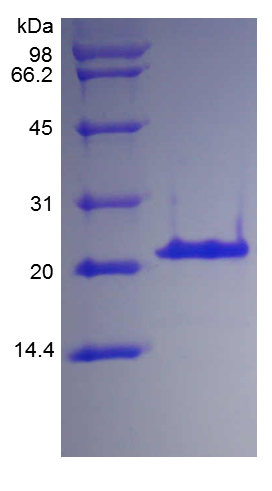- Synonyms
- Growth-hormone-dependant Binding Protein, IBP-3, IGF-binding protein 3
- Source
- Escherichia coli.
- Molecular Weight
- Approximately 28.8 kDa, a single non-glycosylated polypeptide chain containing 264 amino acids.
- AA Sequence
- GASSAGLGPV VRCEPCDARA LAQCAPPPAV CAELVREPGC GCCLTCALSE GQPCGIYTER CGSGLRCQPS PDEARPLQAL LDGRGLCVNA SAVSRLRAYL LPAPPAPGNA SESEEDRSAG SVESPSVSST HRVSDPKFHP LHSKIIIIKK GHAKDSQRYK VDYESQSTDT QNFSSESKRE TEYGPCRREM EDTLNHLKFL NVLSPRGVHI PNCDKKGFYK KKQCRPSKGR KRGFCWCVDK YGQPLPGYTT KGKEDVHCYS MQSK
- Purity
- > 98 % by SDS-PAGE and HPLC analyses.
- Biological Activity
- Fully biologically active when compared to standard. The ED50 as determined by inhibiting IGF-II induced proliferation of serum free human MCF-7 cells is less than 200 ng/ml, corresponding to a specific activity of > 5.0 × 103 IU/mg in the presence of 15 ng/ml of rHuIGF-II.
- Physical Appearance
- Sterile Filtered White lyophilized (freeze-dried) powder.
- Formulation
- Lyophilized from a 0.2 μm filtered concentrated solution in PBS, pH 7.4.
- Endotoxin
- Less than 1 EU/μg of rHuIGF-BP3 as determined by LAL method.
- Reconstitution
- We recommend that this vial be briefly centrifuged prior to opening to bring the contents to the bottom. Reconstitute in sterile distilled water or aqueous buffer containing 0.1 % BSA to a concentration of 0.1-1.0 mg/mL. Stock solutions should be apportioned into working aliquots and stored at ≤ -20 °C. Further dilutions should be made in appropriate buffered solutions.
- Stability & Storage
- Use a manual defrost freezer and avoid repeated freeze-thaw cycles.
- 12 months from date of receipt, -20 to -70 °C as supplied.
- 1 month, 2 to 8 °C under sterile conditions after reconstitution.
- 3 months, -20 to -70 °C under sterile conditions after reconstitution.
- Usage
- This material is offered by Shanghai PrimeGene Bio-Tech for research, laboratory or further evaluation purposes. NOT FOR HUMAN USE.
- SDS-PAGE

- Reference
- 1. Grellier P, Sabbah M, Fouqueray B, et al. 1996. Kidney Int, 49: 1071-8.
2. Yilmaz MD, Hosal AS, Oguz H, et al. 2002. Laryngoscope, 112: 922-5.
3. Deming SL, Ren Z, Wen W, et al. 2007. Breast Cancer Res Treat, 104: 309-19.
4. Satterfield MC, Hayashi K, Song G, et al. 2008. Biol Reprod, 79: 1226-36.
5. Key TJ, Appleby PN, Reeves GK, et al. 2010. Lancet Oncol, 11: 530-42.
- Background
- Insulin-like Growth Factor-Binding Protein 3 (IGF-BP3) belongs to the IGFBP family, which are all cysteinerich proteins with conserved cysteine and have an IGFBP domain and a thyroglobulin type-I domain. Mature human IGF-BP3 contains 264 a.a. with three potential N-linked and two potential O-linked glycosylation sites. It is expressed by most tissues and has higher levels during extrauterine life and peak during puberty. The expression of IGF-BP3 in fibroblasts is stimulated by mitogenic growth factors such as Bombesin, Vasopressin, PDGF, and EGF. The protein forms a ternary complex with IGF-I or II and acid-labile subunit. In this form, it circulates in the plasma, prolonging the half-life of IGFs and altering their interaction with cell surface receptors. Decreased plasma levels of IGF-BP3 often happen during the progression of prostate cancer from benign to metastatic disease.







 COA申请
COA申请
